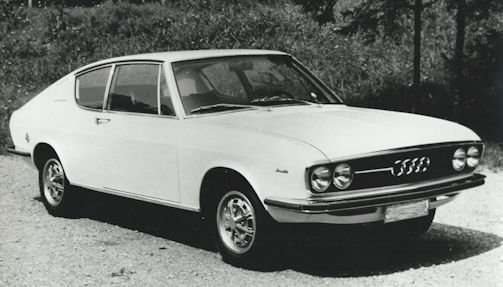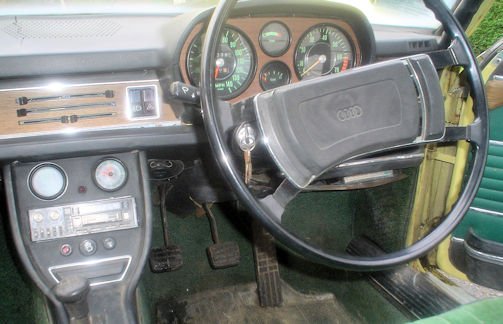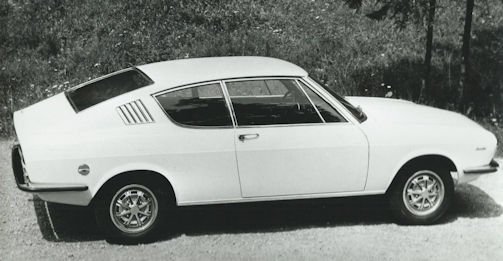Audi 100 Coupe C1 (Type F105)
 | |
Production period: | 1968 to 1977 |
Class : | Sports car |
Body versions : | Sedan , coupe |
Engines: | Petrol :1.6–1.9 liters (59–85 kW) |
Length: | 4398-4635mm |
Broad: | 1729-1750mm |
Height: | 1370-1421mm |
wheelbase : | 2560-2675mm |
curb weight : | 1050-1120kg |
successor | Audi 100 C2 |
The Audi 100 C1 (type F104 or as a coupé F105) is a passenger car of Auto Union GmbH and from 1969 Audi NSU Auto Union AG. The vehicle with a longitudinally installed four-cylinder in-line engine and front-wheel drive was built from October 1968 as a four-door sedan, the two-door version followed in October 1969. Production of the Audi 100 Coupé S, later in 1969 and began production in July 1970.
After 827,474 units were produced, the C1 was replaced in 1976 by the completely newly developed Audi 100 C2.
History
The history of the creation of this car is considered unusual. Essentially, those responsible at Volkswagen in Wolfsburg thought they had acquired another assembly plant in Ingolstadt for the VW Beetle, which was still selling well at the time, with the Daimler-Benz subsidiary Auto Union, which was then threatened with bankruptcy by the mid-1960s. The lack of free capacities there were filled with the assembly of the VW Beetle. The poorly selling DKW F 102 was revised and equipped with a four-stroke engine. The Auto-Union brand Audi was created with this car, which was referred to internally as the “Audi F103”. new. The CEO Heinrich Nordhoff decreed that no more new models should be developed in Ingolstadt.
Ludwig Kraus, who worked at Daimler-Benz until 1963, did not believe in the future of the VW Beetle and developed a new model at Auto Union under the name Audi 100 without the knowledge of the VW board of directors and mostly after work. Nordhoff only got the finished car finally presented. With the Audi 100, a computer-calculated body was developed for the first time in the development of a series vehicle using the finite element method. The plan was to produce a one-off run of 100,000 vehicles, but demand was so great that 827,474 vehicles were made by the end of production.
The secret development of this model was ultimately the reason that Audi remained as an independent brand. In the early 1970s, Audi's modern and easy-to-sell vehicles saved Volkswagen Werk AG, which was struggling with sales problems. With the Beetle and its derivatives up to the VW 411 with air-cooled rear engine, this had technically maneuverer into the sidelines and was only possible by resorting to developments by the subsidiary Audi NSU (VW K 70 - 1970 and Audi 80 - 1972, from 1973 also as the VW Passat) able to expand their range in a short time to modern models with water-cooled front engines and switch to front-wheel drive.

In 1971, production of the Audi 100 was relocated to the former NSU plant in Neckarsulm.
The pricing of the first-generation Audi 100 was quite unusual as from its launch in October 1969 to January 1972, the two-door sedan was just as expensive as the four-door and was remarked that "the two-door sedan itself looks like an elegant coupe"; the design effort for the two-door model with particularly large doors and large rear side panels was also unusually high, which could explain the high pricing policy.
The body welded to the frame-floor assembly was stylistically similar to that of the Audi F103, but significantly larger. The chassis was basically the same, but instead of torsion bar suspension, the front axle was fitted with high-lying coil springs with concentric telescopic shock absorbers (spring-damper unit) with stabilizer. This made it possible to lower the passenger compartment and improve handling. The somewhat dated torsion bar suspension was initially retained on the torsion crank rear axle, but in 1973 the switch was made to a spring-damper unit with coil springs. Rack and pinion steering and dual circuit brake with discs at the front and drums at the rear were further features of the chassis.
Initially, all cars were fitted with four-cylinder engines with displacements of 1.8 l to 1.9 l. They were based on the Audi F103 's engine, adopted from Mercedes, a conventional side-camshaft, pushrod design that, while reliable and economical, but was also rough-running. In 1974 Audi replaced the weakest of the 1760 cc engines with a 1588 cc overhead cam EA827 engine from the new Audi 80.
As early as October 1969, eleven months after the presentation, the Audi 100 LS received a more powerful carburettor at the same time as production of the two-door sedan started, two of which were also installed in the new Audi 100 Coupé S (type F105) from October 1970. From April 1970, the Audi 100 LS was optionally available with a three-speed automatic transmission from VW for a surcharge.
By September 1971 for the new 1972 model year, all sedans received a hatch over the fuel filler cap on the rear right-side panel and the range of engines and equipment was rearranged. The new basic engine was the 1.8-liter engine with 85 hp (63 kW) at 5100 rpm with a compression ratio of 8.5:1 for normal petrol. For a surcharge, it could be combined with the better LS equipment. Audi thus replaced the normal petrol engine of the Audi 100 with 80 hp (59 kW) at 5000 rpm with a compression ratio of 9.1:1 and the premium petrol engine of the Audi 100 S with 90 hp (66 kW) at 5500 rpm Minute with a compression ratio of 10.2:1. In the still available engine with 100 hp (74 kW) at 5500 rpm for the Audi 100 LS for premium petrol, the compression has been reduced for quieter and smoother engine running. The Audi 100 GL with the same 1.9-liter engine as in the 100 Coupé S was the new top-of-the-range sedan model; However, due to a reduced compression (10.0:1 instead of 10.2:1), the power dropped from 115 hp (85 kW) at 5500 rpm to 112 hp (82 kW) at 5800 rpm. The Audi 100 GL received the radiator grille with twin headlights already familiar from the coupé as standard. Just like the coupé, it could be equipped with the three-speed automatic transmission for an extra charge. For the first time, power steering appropriate for the vehicle class was available for all models for an additional charge.

In September 1973, the entire series for the 1974 model year underwent several changes: the front end was revised, fenders and bonnet were designed more angular and all models received a radiator grille made of plastic. Only minor changes were made to the rear of the sedans, the most striking being the new rear lights, which are divided horizontally throughout; the rear of the coupe remained unchanged. The rear wheel suspension was also changed: spring-damper units with coil springs replaced the transverse spring bar. Furthermore, all models received a wiping interval switch as standard and seat belts (on the GL and Coupé S, automatic seat belts with head restraints). A central connector for the VAG diagnostic system introduced in mid-1971 was installed in the engine compartment.
The model series underwent the last major changes in August/September 1974 for the 1975 model year: the front disc brakes were previously on the inside of the gearbox/differential, where they could easily get oily; Audi moved them outwards to the usual position on the wheels. However, their diameter had to be reduced from 280 (291 for the top models) to 257 millimetres. The two circuits of the brake hydraulics were split diagonally instead of a front and a rear circuit. All versions also received wider 5J × 14 rims, which until then had been reserved for the 1.9-litre models. At the same time, the Audi 100, like the Audi 80, received a negative scrub radius. Because the new floating saddle-disc brakes required more space, new, bulbous wheel discs with smaller hubcaps were also required. For the 1975 model year, the saloon also received modified bumpers with black plastic caps on the sides.
At the same time, Audi replaced the basic engine: the weakest version of the 1.8-liter OHV engine was replaced by the nominally equally powerful 1.6-liter EA-827 engine, which was already in the Audi 80; here it could be combined with the simple L and the higher quality LS equipment. However, it had weaker torque, was hardly more economical due to a higher speed level and was not available with power steering. Also in the 1975 model year, the standard steering wheel gearshift was omitted from the 1.8-liter models, it was replaced by the centre gearshift, which had previously been subject to a surcharge.
While the Audi 100 C1 in Europe was replaced by the successor Audi 100 C2 (type 43) in the summer of 1976, production for the North American market continued until March 1977. A total of 827,474 vehicles were built, of which 30,687 were the Audi 100 Coupé S.
Audi 100 Coupé S
The coupe version of the Audi 100 C1 declined, as did the sedan, on the initiative of Ludwig Kraus, who wanted a coupe in the revived Audi lineup. The body design was shaped by a then young Hartmut who later became Head of Design at Volkswagen in the 1990s. When developing the Audi 100 Coupé S, it was decided not to deviate too far from the original design dictated by the sedan. The debut of the Audi 100 Coupé S took place in September 1969 at the IAA in Frankfurt, but the actual market launch took place more than a year later, i.e. in October 1970.
Based on the sedan, the wheelbase was shortened from 2675 to 2560 mm, with no new pressing tools being required to produce the frame floor system. In addition, the rear overhang has been shortened by 127 mm. In order to realize the sporty hatchback coupé, the A-pillar and doors were also redesigned. The rear pillar carried large ventilation slots. The hatchback made the car 67 mm flatter than the sedan. The passenger compartment has been reinforced with a reinforced bulkhead area, stiff side members as outer rocker panels and a cross member in the rear area. The front received new split round headlights, a solution that was introduced for the first time in the coupe and was only offered as an option in the sedan the following year. The tire dimension grew from 165 to 185 mm in cross-section, but still with 14-inch diameter rims. In addition, the front disc brakes were now ventilated and had four-piston callipers.
The Coupé S was given the 1.8-liter engine with a displacement of 1.9 Liters. The increase in displacement resulted in an increase in output to 115 hp at the same speed. Initially, a 100 hp variant was also to be included in the coupé range, but ultimately the larger engine was the only choice.
The interior of the Audi 100 Coupé S looked neater than that of the sedan. It contained, among other things, a partially upholstered wooden dashboard, seats with headrests and a 4-spoke sports steering wheel, which - exclusive to this series - was also slightly height-adjustable (the vertical deflection of the adjustment was 4 centimetres).
The first further development of the Audi 100 Coupé S came a year after its market launch in October 1971, when the car was also available with an optional 3-speed automatic transmission. At the same time, instead of two carburettors, the 1.9-liter engine received only one, so the power, albeit slightly, dropped to 112 hp. These changes, and all that followed, paralleled those experienced by the Audi 100 sedan, including modifications to the 1973 body to meet US crash test regulations, complemented by careful restyling both in the same and in the following year, as well as updates to the chassis and braking system.
In 1976 there was a test vehicle fleet for purely electric vehicles called EEP (Audi with RWE and Varta). "The 100 (C1) battery-powered electric experimental car was then manufactured to test different accumulators, which could be recharged via a "coupling device" (socket) near the front (US) bumper." In the summer of 1976, the last Audi 100 Coupé S rolled off the assembly line in Neckarsulm.
In South Africa, where the 100 was also built, the 100 was available as an L, LS, GL and S coupe. Local production began towards the end of 1972; 33,000 units were built in South Africa by October 1976. The GL received a vinyl roof and the lettering GL on the C-pillar. The coupé was no longer produced. The LS and GLS were special versions of the L and GL, with silver paint, automatic transmission and special red interior. The L and LS have a 75 kW (102 PS; 101 PS) DIN 1760 cc engine, while the GL and GLS have the larger 84 kW (114 PS; 113 PS) 1871 cc engine.
In the United States, the Audi 100 appeared in 1970 as the LS with a 1.8-liter SAE engine with 115 hp (86 kW) and a choice of two or four doors. For 1972 the engine was enlarged to 1.9 litres but SAE net power dropped to 91 hp (68 kW). There was a base and a GL model, as well as an automatic transmission. For 1974 the model line was again limited to the 100 LS, but with the larger safety bumpers. For 1975, power was increased to 95 hp (71 kW) by switching to fuel injection. Standard equipment was improved while prices went up. Until about May 1977, the Audi 100 was still produced exclusively for the USA parallel to the successor. In August 1977, the new Audi 5000 the 100, although 537 vehicles were still sold in 1978. The coupe was not available in the United States.

Rating
Technical
-
Model Variants
- Audi 100 (1760 cc, 80, later 85 hp, a downdraft carburetor )
- Audi 100 S (1760 cm³, 90 hp, a downdraft register carburettor , super petrol)
- Audi 100 L (from October 1974; 1577 cm³, 85 hp, a downdraft register carburettor Solex 32/35 DIDTA)
- Audi 100 LS (1760 cc, 85 hp with a downdraft carburetor Solex 35 PDSIT-5, 100 hp with a downdraft register carburetor Solex 32/35 TDID; from January 1976: 1577 cc, 85 hp, a downdraft register carburetor Zenith 2 B 2)
- Audi 100 GL (from August 1971; 1871 cm³, 112 hp, a downdraft register carburettor Solex 32/35 TDID, double headlights)
- Audi 100 Coupé S (1871 cm³, 115 hp with two downdraft register carburettors Solex 32/35 TDID, from autumn 1971 with 112 hp and a carburettor Solex 32/35 TDID)
special bodies
- Audi 100 LS Cabriolet ( Karmann /Osnabrück)
- Audi 100 LS Cabriolet ( Karl Deutsch /Cologne)
- Audi 100 Convertible ( Crayford Engineering )
- Audi 100 LS Estate Wagon ( Crayford Engineering )
Specifications
Model
100 GL
100 Coupé Sengine
Water-cooled four-cylinder four-stroke in -line engine , inclined to the right, longitudinally installed ,
five-bearing crankshaft , pressure circulation lubrication , camshaft
below driven via duplex timing chain , bumpers , rocker arm
100 L from September 1974: overhead camshaft driven via toothed belt , bucket tappetsmixture generation
Two a downdraft register carburettor
with automatic startdisplacement
1871cc
bore × stroke
84×84.4mm
max. power
kW (hp)
at 1/min82 (112)/5800
85 (115)/5800 ctransmission
Front-wheel drive , fully synchronized four-speed manual gearbox behind the front axle,
steering wheel gearshift , a. W. Center shift (standard on Coupé S and GL, from October 1974 all models),
from August 1970 with 100/112 hp engine: a. W. Three-speed automatic transmission with hydraulic converterfront axle
Double wishbones , spring-damper units with coil springs, anti-roll bar ,
disc brakes (internally ventilated in the Coupé S), internal in all models up to August 1974rear axle
Torsion crank axle : rigid axle on supporting levers, Panhard rod for lateral guidance,
until August 1973: torsion bar springs , from September 1973: coil springs,
hydraulic telescopic shock absorbers , drum brakesDimensions
Length: 4610 mm (100 LS/GL: 4636 mm, Coupé S: 4400 mm)
Width: 1728 mm (100 LS/GL: 1730 mm, Coupé S: 1750 mm)
Height: 1414 mm (100 LS/GL: 1422 mm , Coupé S: 1341 mm)
Curb weight: 1050 kg (100 LS/GL: 1090-1120 kg, Coupé S: 1100/1120 kg)body
Self-supporting sheet steel body, tank capacity 58 liters
steering
Rack and pinion steering , turning circle 11.1 meters
wheelbase
two- and four-door sedan: 2675 mm, coupe S: 2560 mm
a only 100 Coupé S up to August 1971, from September 1971: A downdraft register carburettor with automatic start
b from 1971
c Audi 100 Coupé S only (until August 1971)
Production figures Audi 100 C1
Production of vehicles from 1968 to 1976
type des.
1969
1970
1971
1972
1973
1974
1975
1976
total
100, 100LS,L,LS 2 doors
1,079
4.113
1,265
5.361
4,833
1,813
3,487
1,764
23,715
100 S 2 doors
1,602
4,648
1,329
0
0
0
0
0
7,579
100 LS 2 doors
2,489
12,597
10,928
14,186
14,173
11.102
3,976
2,590
72,041
100 GL 2 doors
685
5,583
3,957
1.124
806
306
12,461
100 coupe S
3
741
8,586
8,406
7,989
2,490
1,476
996
30,687




